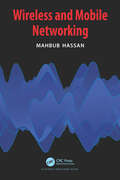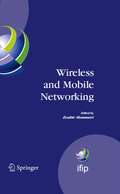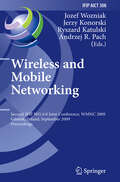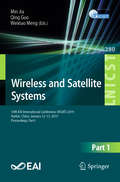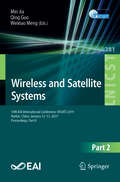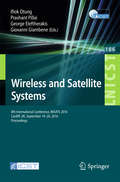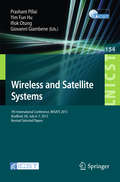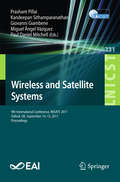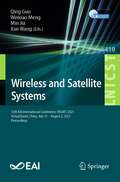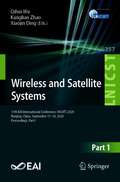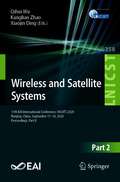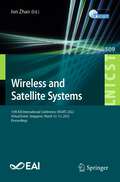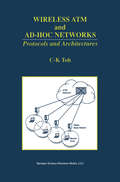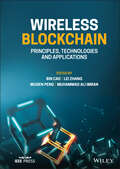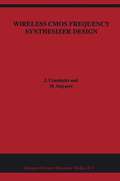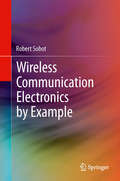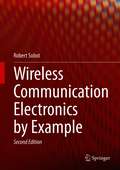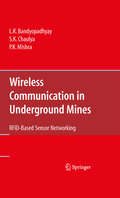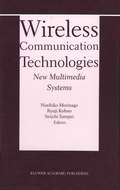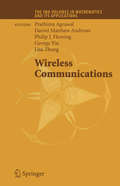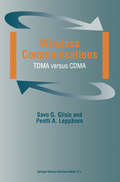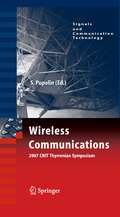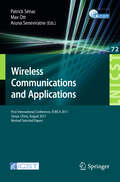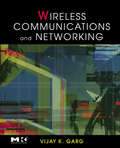- Table View
- List View
Wireless and Mobile Networking
by Mahbub HassanThere has been phenomenal uptake of wireless and mobile networking technologies in the past decades. Significant developments have taken place during this time making the wireless technology more affordable, effective, and reliable. This book explains the fundamental principles and protocols of key existing and emerging wireless networking technologies. The book begins with a review of the fundamentals of wireless communications. It covers the basic theories and terminologies of coding and modulation, which maps digital information to the underlying signal, as well as the models to capture the dynamics of wireless signal propagation in the environment. It provides in-depth coverage of the WiFi evolution covering both the mainstream WiFi, which operates in 2.4/5GHz with new versions targeting 6GHz, as well as some of the niche WiFi standards that operate outside the mainstream bands such as 802.11af in 700MHz TV bands, 802.11ah in 900MHz to connect the Internet of Things (IoT), and 802.11ad/ay in 60GHz to support multi-gigabit applications. The book covers the fundamental concepts of cellular networks, examines the advancements brought forth by each generation, and discusses new applications and the underpinning wireless technologies promised by 5G. It also covers a recently developed long-range low-power wireless networking technology called LoRa, which is the fastest growing technology to connect millions of IoT sensors and devices throughout the world. The concluding chapters examine emerging wireless paradigms such as Artificial Intelligence for wireless networking, sensing with wireless signals, and mobile networking with flying base stations carried by drones and unmanned aerial vehicles (UAVs). With many worked-out examples, illustrative figures, and multiple choice questions, this book is an ideal for students and a valuable reference for anyone working in this rapidly evolving field.
Wireless and Mobile Networking: IFIP Joint Conference on Mobile Wireless Communications Networks (MWCN'2008) and Personal Wireless Communications (PWC'2008), Toulouse, France, September 30 - October 2, 2008 (IFIP Advances in Information and Communication Technology #284)
by Zoubir MammeriResearch and development in wireless and mobile networks and services areas have been going on for some time, reaching the stage of products. Graceful evo- tion of networks, new access schemes, flexible protocols, increased variety of services and applications, networks reliability and availability, security, are some of the present and future challenges that have to be met. MWCN (Mobile and Wireless Communications Networks) and PWC (Personal Wireless Communications) are two conferences sponsored by IFIP WG 6.8 that provide forum for discussion between researchers, practitioners and students interested in new developments in mobile and wireless networks, services, applications and computing. In 2008, MWCN and PWC were held in Toulouse, France, from September 30 to October 2, 2008. MWNC’2008 and PWC’2008 were coupled to form the first edition of IFIP Wireless and Mobile Networking Conference (WMNC’2008). MWCN and PWC topics were revisited in order to make them complementary and covering together the main hot issues in wireless and mobile networks, services, applications, computing, and technologies.
Wireless and Mobile Networking: Second IFIP WG 6.8 Joint Conference, WMNC 2009, Gdansk, Poland, September 9-11, 2009, Proceedings (IFIP Advances in Information and Communication Technology #308)
by Jozef Wozniak Jerzy Konorski Ryszard Katulski Andrzej R. PachRecent spectacular achievements in wireless, mobile, and sensor networks have dramatically changed our lives in many ways. However, the rapid evolution of wireless systems not only promises increased functionality, reliability, availability, and security, as well as putting a wide variety of new services at the users’ disposal ? it also creates a number of design challenges that our research community is now facing. Scientists and engineers need to come up with, and promptly implement, novel wireless network architectures, while system operators and planners rethink their business models and attend to the growing expectations of their customer base. To provide a suitable forum for discussion between researchers, practitioners, and industry representatives interested in new developments in the respective research area, IFIP WG 6. 8 launched three separate series of conferences: MWCN (Mobile and Wireless Communications Networks), PWC (Personal Wireless Communications), and WSAN (Wireless Sensor and Actors Networks). In 2008, MWCN and PWC were merged into the IFIP Wireless and Mobile Networking Conference (WMNC 2008), held in Toulouse, France, from September 30 to October 2, 2008. MWNC 2008 and PWC 2008 topics were subsequently revised with a view to covering the whole spectrum of hot issues in wireless and mobile networking. As a result, IFIP WG 6. 8 decided to add WSAN as another WMNC track.
Wireless and Satellite Systems: 10th EAI International Conference, WiSATS 2019, Harbin, China, January 12–13, 2019, Proceedings, Part I (Lecture Notes of the Institute for Computer Sciences, Social Informatics and Telecommunications Engineering #280)
by Min Jia Qing Guo Weixiao MengThis two-volume set LNICST 280-281 constitutes the post-conference proceedings of the 10th EAI International Conference on Wireless and Satellite Services, WiSATS 2019, held in Harbin, China, in January 2019. The conference was formerly known as the International Conference on Personal Satellite Services (PSATS) mainly covering topics in the satellite domain. The 137 full papers were carefully reviewed and selected from 289 submissions. The papers are organized in topical sections on machine learning for satellite-terrestrial networks, human-machine interactive sensing, monitoring, and communications, integrated space and onboard networks, intelligent signal processing, wireless communications and networks, vehicular communications and networks, intelligent 5G communication and digital image processing technology, security, reliability and resilience in internet of things, advances in communications and computing for internet of things.
Wireless and Satellite Systems: 10th EAI International Conference, WiSATS 2019, Harbin, China, January 12–13, 2019, Proceedings, Part II (Lecture Notes of the Institute for Computer Sciences, Social Informatics and Telecommunications Engineering #281)
by Min Jia Qing Guo Weixiao MengThis two-volume set LNICST 280-281 constitutes the post-conference proceedings of the 10th EAI International Conference on Wireless and Satellite Services, WiSATS 2019, held in Harbin, China, in January 2019. The conference was formerly known as the International Conference on Personal Satellite Services (PSATS) mainly covering topics in the satellite domain. The 137 full papers were carefully reviewed and selected from 289 submissions. The papers are organized in topical sections on machine learning for satellite-terrestrial networks, human-machine interactive sensing, monitoring, and communications, integrated space and onboard networks, intelligent signal processing, wireless communications and networks, vehicular communications and networks, intelligent 5G communication and digital image processing technology, security, reliability and resilience in internet of things, advances in communications and computing for internet of things.
Wireless and Satellite Systems: 8th International Conference, WiSATS 2016, Cardiff, UK, September 19-20, 2016, Proceedings (Lecture Notes of the Institute for Computer Sciences, Social Informatics and Telecommunications Engineering #186)
by Ifiok Otung Prashant Pillai George Eleftherakis Giovanni GiambeneThis book constitutes the proceedings of the 8th International Conference on Wireless and Satellite Services, WiSATS 2016, held in Cardiff, UK, in September 2016. The conference was formerly known as the International Conference on Personal Satellite Services (PSATS) mainly covering topics in the satellite domain. As the scope of the conference widened to include wireless systems, the conference was renamed WiSATS. The 22 revised papers were selected from 32 submissions and cover a broad range of related state-of-the-art topics in antennas and mobile terminals, symbol precoding and network coding schemes, energy efficient strategies in satellite communication and cloud radio access networks, smart grid communication and optimization, security issues in vehicular ad-hoc networks (VANET) and delay tolerant net-works (DTN), interference mitigation in high throughput geostationary and non-geostationary satellite systems.
Wireless and Satellite Systems: 7th International Conference, WiSATS 2015, Bradford, UK, July 6-7, 2015. Revised Selected Papers (Lecture Notes of the Institute for Computer Sciences, Social Informatics and Telecommunications Engineering #154)
by Prashant Pillai Yim Fun Hu Ifiok Otung Giovanni GiambeneThis book constitutes the proceedings of the 7th International Conference on Wireless and Satellite Services, WiSATS 2015, held in Bradford, UK, in July 2015. The conference was formerly known as the International Conference on Personal Satellite Services (PSATS) mainly covering topics in the satellite domain. As the scope of the conference widened to include wireless systems, the conference was renamed to WiSATS. The 29 revised papers were presented at the conference in three technical sessions and one special session on “Network Coding for Satellites”. WiSATS 2015 also hosted two workshops along with the main conference: The first workshop, Communication Applications in Smart Grid (CASG 2015), focused on the merging area of using communication technology within the electricity power grid for smart monitoring and control. The second workshop, Advanced Next-Generation Broadband Satellite Systems (BSS 2015), focused on the use of satellite systems for providing next-generation broadband services.
Wireless and Satellite Systems: 9th International Conference, WiSATS 2017, Oxford, UK, September 14-15, 2017, Proceedings (Lecture Notes of the Institute for Computer Sciences, Social Informatics and Telecommunications Engineering #231)
by Prashant Pillai Kandeepan Sithamparanathan Giovanni Giambene Miguel Ángel Vázquez Paul Daniel MitchellThis book constitutes the proceedings of the 9th International Conference on Wireless and Satellite Services, WiSATS 2017, held in Oxford, UK, in September 2017. The conference was formerly known as the International Conference on Personal Satellite Services (PSATS) mainly covering topics in the satellite domain. The aim of this conference is to bring together researchers, developers and practitioners from around the world in the field of wireless and satellite systems. The theme of WiSATS 2017 was on the means of using the wireless and satellite services directly to the user for personal communications, multimedia and location identification.
Wireless and Satellite Systems: 12th EAI International Conference, WiSATS 2021, Virtual Event, China, July 31 – August 2, 2021, Proceedings (Lecture Notes of the Institute for Computer Sciences, Social Informatics and Telecommunications Engineering #410)
by Xue Wang Weixiao Meng Min Jia Qing GuoThis book constitutes the refereed post-conference proceedings of the 12th International Conference on Wireless and Satellite Services, WiSATS 2021, held in Nanjing, China, in September 2020. Due to COVID-19 pandemic the conference was held virtually. The 79 full papers were carefully reviewed and selected from 140 submissions. The conference’s central theme is the means of using the wireless and satellite services directly to the user for personal communications, multimedia and location identification. The services enabled by WiSATS not only cover the requirements of an ordinary citizen but also provide personal and public services for global coverage communications as the applications of internet of things.
Wireless and Satellite Systems: 11th EAI International Conference, WiSATS 2020, Nanjing, China, September 17-18, 2020, Proceedings, Part I (Lecture Notes of the Institute for Computer Sciences, Social Informatics and Telecommunications Engineering #357)
by Qihui Wu Kanglian Zhao Xiaojin DingThis two-volume set LNICST 357-358 constitutes the post-conference proceedings of the 11th EAI International Conference on Wireless and Satellite Services, WiSATS 2020, held in Nanjing, China, in September 2020. The 91 full papers and workshop papers were carefully reviewed and selected from 200 submissions. Part I - LNICST 357 - details original research and results of wireless and satellite technology for a smarter global communication architecture. The theme of WISATS 2020 is “Intelligent Wireless and Satellite Communications for Beyond 5G”. Part II – LNICST 358 - presents 6 workshop papers: High Speed Space Communication and Space Information Networks (HSSCSIN); Integrated Space and Onboard Networks (ISON); Intelligent Satellite Operations, Managements, and Applications (ISOMA); Intelligent Satellites in Future Space Networked System (ISFSNS); Satellite Communications, Networking and Applications (SCNA); Satellite Internet of Things; Trusted Data Sharing, Secure Communication (SIOTTDSSC).
Wireless and Satellite Systems: 11th EAI International Conference, WiSATS 2020, Nanjing, China, September 17-18, 2020, Proceedings, Part II (Lecture Notes of the Institute for Computer Sciences, Social Informatics and Telecommunications Engineering #358)
by Qihui Wu Kanglian Zhao Xiaojin DingThis two-volume set LNICST 357-358 constitutes the post-conference proceedings of the 11th EAI International Conference on Wireless and Satellite Services, WiSATS 2020, held in Nanjing, China, in September 2020. The 91 full papers and workshop papers were carefully reviewed and selected from 200 submissions. Part I - LNICST 357 - details original research and results of wireless and satellite technology for a smarter global communication architecture. The theme of WISATS 2020 is “Intelligent Wireless and Satellite Communications for Beyond 5G”. Part II – LNICST 358 - presents 6 workshop papers: High Speed Space Communication and Space Information Networks (HSSCSIN); Integrated Space and Onboard Networks (ISON); Intelligent Satellite Operations, Managements, and Applications (ISOMA); Intelligent Satellites in Future Space Networked System (ISFSNS); Satellite Communications, Networking and Applications (SCNA); Satellite Internet of Things; Trusted Data Sharing, Secure Communication (SIOTTDSSC).
Wireless and Satellite Systems: 13th EAI International Conference, WiSATS 2022, Virtual Event, Singapore, March 12-13, 2023, Proceedings (Lecture Notes of the Institute for Computer Sciences, Social Informatics and Telecommunications Engineering #509)
by Jun ZhaoThis book constitutes the refereed post-conference proceedings of the 13th International Conference on Wireless and Satellite Services, WiSATS 2022, held in March 12-13, 2023. Due to COVID-19 pandemic the conference was held virtually. The 9 full papers were carefully reviewed and selected from 23 submissions. They were organized in topical sections as follows: Security and Privacy in Healthcare, Transportation, and Satellite Networks, Advanced Technologies in Wireless Communication Systems, Network Efficiency and Reliability.
Wireless ATM and Ad-Hoc Networks: Protocols and Architectures
by C. K. TohATM is regarded as the next high speed multimedia networking paradigm. Mobile computing, which is a confluence of mobile communications, computing and networks, is changing the way people work. Wireless ATM combines wireless and ATM technologies to provide mobility support and multimedia services to mobile users. Wireless ATM and Ad-Hoc Networks: Protocols and Architectures, a consolidated reference work, presents the state of the art in wireless ATM technology. It encompasses the protocol and architectural aspects of Wireless ATM networks. The topics covered in this book include: mobile communications and computing, fundamentals of ATM and Wireless ATM, mobile routing and switch discovery, handover protocol design and implementation, mobile quality of service, unifying handover strategy for both unicast and multicast mobile connections, and roaming between Wireless ATM LANs. A novel routing protocol for ad-hoc mobile networks (also known as Cambridge Ad-hoc) is also presented in this book along with information about ETSI HIPERLAN, the RACE Mobile Broadband System, and SUPERNET. This timely book is a valuable reference source for researchers, scientists, consultants, engineers, professors and graduate students working in this new and exciting field.
Wireless Blockchain: Principles, Technologies and Applications (IEEE Press)
by Bin Caop>Explore foundational concepts in blockchain theory with an emphasis on recent advances in theory and practice In Wireless Blockchain: Principles, Technologies and Applications, accomplished researchers and editors Bin Cao, Lei Zhang, Mugen Peng, and Muhammad Ali Imran deliver a robust and accessible exploration of recent developments in the theory and practice of blockchain technology, systems, and potential application in a variety of industrial sectors, including manufacturing, entertainment, public safety, telecommunications, public transport, healthcare, financial services, automotive, and energy utilities. The book presents the concept of wireless blockchain networks with different network topologies and communication protocols for various commonly used blockchain applications. You’ll discover how these variations and how communication networks affect blockchain consensus performance, including scalability, throughput, latency, and security levels. You’ll learn the state-of-the-art in blockchain technology and find insights on how blockchain runs and co-works with existing systems, including 5G, and how blockchain runs as a service to support all vertical sectors efficiently and effectively. Readers will also benefit from the inclusion of: A thorough introduction to the Byzantine Generals problem, the fundamental theory of distributed system security and the foundation of blockchain technology An overview of advances in blockchain systems, their history, and likely future trends Practical discussions of Proof-of-Work systems as well as various Proof-of-“X” alternatives, including Proof-of-Stake, Proof-of-Importance, and Proof-of-Authority A concise examination of smart contracts, including trusted transactions, smart contract functions, design processes, and related applications in 5G/B5G A treatment of the theoretical relationship between communication networks and blockchain Perfect for electrical engineers, industry professionals, and students and researchers in electrical engineering, computer science, and mathematics, Wireless Blockchain: Principles, Technologies and Applications will also earn a place in the libraries of communication and computer system stakeholders, regulators, legislators, and research agencies.
Wireless Blockchain: Principles, Technologies and Applications (IEEE Press)
by Bin Cao Lei Zhang Mugen Peng Muhammad Ali Imranp>Explore foundational concepts in blockchain theory with an emphasis on recent advances in theory and practice In Wireless Blockchain: Principles, Technologies and Applications, accomplished researchers and editors Bin Cao, Lei Zhang, Mugen Peng, and Muhammad Ali Imran deliver a robust and accessible exploration of recent developments in the theory and practice of blockchain technology, systems, and potential application in a variety of industrial sectors, including manufacturing, entertainment, public safety, telecommunications, public transport, healthcare, financial services, automotive, and energy utilities. The book presents the concept of wireless blockchain networks with different network topologies and communication protocols for various commonly used blockchain applications. You’ll discover how these variations and how communication networks affect blockchain consensus performance, including scalability, throughput, latency, and security levels. You’ll learn the state-of-the-art in blockchain technology and find insights on how blockchain runs and co-works with existing systems, including 5G, and how blockchain runs as a service to support all vertical sectors efficiently and effectively. Readers will also benefit from the inclusion of: A thorough introduction to the Byzantine Generals problem, the fundamental theory of distributed system security and the foundation of blockchain technology An overview of advances in blockchain systems, their history, and likely future trends Practical discussions of Proof-of-Work systems as well as various Proof-of-“X” alternatives, including Proof-of-Stake, Proof-of-Importance, and Proof-of-Authority A concise examination of smart contracts, including trusted transactions, smart contract functions, design processes, and related applications in 5G/B5G A treatment of the theoretical relationship between communication networks and blockchain Perfect for electrical engineers, industry professionals, and students and researchers in electrical engineering, computer science, and mathematics, Wireless Blockchain: Principles, Technologies and Applications will also earn a place in the libraries of communication and computer system stakeholders, regulators, legislators, and research agencies.
Wireless CMOS Frequency Synthesizer Design (The Springer International Series in Engineering and Computer Science #439)
by J. Craninckx Michiel SteyaertThe recent boom in the mobile telecommunication market has trapped the interest of almost all electronic and communication companies worldwide. New applications arise every day, more and more countries are covered by digital cellular systems and the competition between the several providers has caused prices to drop rapidly. The creation of this essentially new market would not have been possible without the ap pearance of smalI, low-power, high-performant and certainly low-cost mobile termi nals. The evolution in microelectronics has played a dominant role in this by creating digital signal processing (DSP) chips with more and more computing power and com bining the discrete components of the RF front-end on a few ICs. This work is situated in this last area, i. e. the study of the full integration of the RF transceiver on a single die. Furthermore, in order to be compatible with the digital processing technology, a standard CMOS process without tuning, trimming or post-processing steps must be used. This should flatten the road towards the ultimate goal: the single chip mobile phone. The local oscillator (LO) frequency synthesizer poses some major problems for integration and is the subject of this work. The first, and also the largest, part of this text discusses the design of the Voltage Controlled Oscillator (VCO). The general phase noise theory of LC-oscillators is pre sented, and the concept of effective resistance and capacitance is introduced to char acterize and compare the performance of different LC-tanks.
Wireless Communication Electronics by Example
by Robert SobotThis book is intended for senior undergraduate and graduate students as well as practicing engineers who are involved in design and analysis of radio frequency (RF) circuits. Fully-solved, tutorial-like examples are used to put into practice all major topics required to understand the principles underlying the main sub-circuits required to design an RF transceiver and the whole communication system. Starting with review of principles in electromagnetic (EM) transmission and signal propagation, through detailed practical analysis of RF amplifier, mixer, modulator, demodulator, and oscillator circuit topologies, all the way to the system communication theory behind the RF transceiver operation, this book systematically covers all relevant aspects in a way that is suitable for a single semester university level course. Readers will benefit from the author’s sharp focus on radio receiver design, demonstrated through hundreds of fully-solved, realistic examples, as opposed to texts that cover many aspects of electronics and electromagnetic without making the required connection to wireless communication circuit design.
Wireless Communication Electronics by Example
by Robert SobotThis book is intended for senior undergraduate and graduate students as well as practicing engineers who are involved in design and analysis of radio frequency (RF) circuits. Fully-solved, tutorial-like examples are used to put into practice major topics and to understand the underlying principles of the main sub-circuits required to design an RF transceiver and the whole communication system. Starting with review of principles in electromagnetic (EM) transmission and signal propagation, through detailed practical analysis of RF amplifier, mixer, modulator, demodulator, and oscillator circuit topologies, as well as basics of the system communication theory, this book systematically covers most relevant aspects in a way that is suitable for a single semester university level course. Readers will benefit from the author’s sharp focus on radio receiver design, demonstrated through hundreds of fully-solved, realistic examples, as opposed to texts that cover many aspects of electronics and electromagnetic without making the required connection to wireless communication circuit design.Offers readers a complete, self-sufficient tutorial style textbook;Includes all relevant topics required to study and design an RF receiver in a consistent, coherent way with appropriate depth for a one-semester course;Uses hundreds of fully-solved, realistic examples of radio design technology to demonstrate concepts;Explains necessary physical/mathematical concepts and their interrelationship.
Wireless Communication in Underground Mines: RFID-based Sensor Networking
by L. K. Bandyopadhyay S. K. Chaulya P. K. MishraWireless communication has emerged as an independent discipline in the past decades. Everything from cellular voice telephony to wireless data transmission using wireless sensor networks has profoundly impacted the safety, production, and productivity of industries and our lifestyle as well. After a decade of exponential growth, the wireless industry is one of the largest industries in the world. Therefore, it would be an injustice if the wireless communication is not explored for mining industry. Underground mines, which are characterized by their tough working conditions and hazardous environments, require fool-proof mine-wide communication systems for smooth functioning of mine workings and ensuring better safety. Proper and re- able communication systems not only save the machine breakdown time but also help in immediate passing of messages from the vicinity of underground working area to the surface for day-to-day normal mining operations as well as for speedy rescue operations in case of disaster. Therefore, a reliable and effective commu- cation system is an essential requisite for safe working, and maintaining requisite production and productivity of underground mines. Most of the existing systems generally available in underground mines are based on line (wired) communication principle, hence these are unable to withstand in the disaster conditions and dif?cult to deploy in inaccessible places. Therefore, wireless communication is an indispe- able, reliable, and convenient system and essential in case of day-to-day normal duty or disaster situations.
Wireless Communication Technologies: New MultiMedia Systems (The Springer International Series in Engineering and Computer Science #564)
by Norihiko Morinaga Ryuji Kohno Seiichi SampeiDuring 12-15 of September 1999, 10th International Symposium on P- sonal, Indoor and Mobile Radio Communications (PIMRC’99) was held in Osaka Japan, and it was really a successful symposium that accommodated more than 600 participants from more than 30 countries and regions. PIMRC is really well organized annual symposium for wireless multimedia commu- cation systems, in which, various up-to-date topics are discussed in the invited talk, panel discussions and tutorial sessions. One of the unique features of the PIMRC is that PIMRC is continuing to publish, from Kluwer Academic Publishers since 1997, a book that collects the hottest topics discussed in PIMRC. In PIMRC’97, Invited talks were sum- rized in “Wireless Communications –TDMA versus CDMA – (ISBN 0-7923- 8005-3),” and it was published just beforePIMRC’97. This book was also distributed to all the PIMRC’97 participants as a part of proceedings for the conference. In PIMRC’98, extendedversion of the invited papers were s- marized in Wireless Multimedia Network Technologies (ISBN 0-7923-8633- 7) and published in September 1999, which is almost the same timing for the PIMRC’99. In the case of PIMRC’99, to produce more informative book, we have - lected topics that attracted many PIMRC’99 participants during the conf- ence, and invited prospective authors not only from the invited speakers but also from tutorial speakers, panel organizers, panelists, and some other exc- lent PIMRC’99 participants.
Wireless Communications (The IMA Volumes in Mathematics and its Applications #143)
by Prathima Agrawal Matthew D. Andrews Philip J. Fleming G. George Yin Lisa ZhangThis volume contains papers based on invited talks given at the 2005 IMA Summer Workshop on Wireless Communications, held at the Institute for Mathematics and Its Applications, University of Minnesota, June 22 - July 1, 2005. It presents some of the highlights of the workshop, and collects papers covering a broad spectrum of important and pressing issues in wireless communications.
Wireless Communications: TDMA versus CDMA
by Savo G. Glisic Pentti A. LeppänenIn Time Division Multiple Access (TDMA), within a given time frame a particular user is allowed to transmit within a given time slot. This technique is used in most of the second-generation digital mobile communication systems. In Europe the system is known as GSM, in USA as DAMPS and in Japan as MPT. In Code Division Multiple Access (CDMA) every user is using a distinct code so that it can occupy the same frequency bandwidth at the same time with other users and still can be separated on the basis of low correlation between the codes. These systems like IS-95 in the USA are also developed and standardized within the second generation of the mobile communication systems. CDMA systems within a cellular network can provide higher capacity and for this reason they become more and more attractive. At this moment it seems that both TDMA and CDMA remain viable candidates for application in future systems. Wireless Communications: TDMA versus CDMA provides enough information for correct understanding of the arguments in favour of one or other multiple access technique. The final decision about which of the two techniques should be employed will depend not only on technical arguments but also on the amount of new investments needed and compatibility with previous systems and their infrastructures. Wireless Communications: TDMA versus CDMA comprises a collection of specially written contributions from the most prominent specialists in wireless communications in the world today and presents the major, up to date, issues in this field. The material is grouped into four chapters: Communication theory, covering coding and modulation, Wireless communications, Antenna & Propagation and Advanced Systems & Technology. The book describes clearly the issues and presents the information in such a way that informed decisions about third generation wireless systems can be taken. It is essential reading for all researchers, engineers and managers working in the field of Wireless Communications.
Wireless Communications 2007 CNIT Thyrrenian Symposium (Signals and Communication Technology)
by Silvano PupolinThe 18th Tyrrhenian Workshop on digital communications is devoted to wi- less communications. In the last decade, wireless communications research boosted launching new standards and proposing new techniques for the - cess technology. We moved from the UTRA standard capable to transmit 0. 5bit/s/Hz to WLAN which is promising 2. 7bit/s/Hz. Now wireless c- munication systems are facing a ?ourishing of new proposal moving from multiple antennas at transmitter and receiver side (MIMO systems), to new powerfulForwardErrorCorrectionCodes,toadaptiveradioresourcemana- mentalgorithms. Thenewchallenge,however,isthemovetowardsmultimedia communications and IP technology. This move implies e?orts in several new aspects. First of all an open network, as IP is, imposes the necessity of a - cure network, to guarantee the privacy of the ongoing communications, avoid the use of the networks by unauthorized customers, avoid the misuses and the charge to third parties of the cost of the connection. Also, quality of service (QoS) of the communications is becoming a must in IP networks which are carrying services which need a guaranteed QoS as telephony, real time s- vices, etc. To get this new target some form of access control to the network must be setup. Recently, new form of communication networks has appeared to collect data for several applications (sensor networks, ad hoc networks, etc. ) and they need a connection with a backbone network which could be a wireless one with a larger range than the sensor or ad hoc networks.
Wireless Communications and Applications: First International Conference, ICWCA 2011, Sanya, China, August 1-3, 2011, Revised Selected Papers (Lecture Notes of the Institute for Computer Sciences, Social Informatics and Telecommunications Engineering #72)
by Patrick Sénac Max Ott Aruna SeneviratneThis book constitutes the thoroughly refereed post-conference proceedings of the First International ICST Conference on Wireless Communications and Applications, ICWCA 2011, held in Sanya, China, in August 2011. The 43 revised full papers presented were carefully reviewed and selected from around 90 submissions and cover a wide range of topics as mobile ad hoc networks, sensor networks, network architectural design, network protocol design, local area networks, MAC, routing, and transport protocols, quality of service provisioning, reliability and fault tolerance issues, resource allocation and management, signal processing, medical imaging, data aggregation techniques, security and privacy issues, wireless computing and applications for wireless network as smart grid, agriculture, health care, smart home, conditional monitoring, etc.
Wireless Communications & Networking (ISSN)
by Vijay GargThis book provides comprehensive coverage of mobile data networking and mobile communications under a single cover for diverse audiences including managers, practicing engineers, and students who need to understand this industry. In the last two decades, many books have been written on the subject of wireless communications and networking. However, mobile data networking and mobile communications were not fully addressed in a unified fashion. This book fills that gap in the literature and is written to provide essentials of wireless communications and wireless networking, including Wireless Personal Area Networks (WPAN), Wireless Local Area Networks (WLAN), and Wireless Wide Area Networks (WWAN). The first ten chapters of the book focus on the fundamentals that are required to study mobile data networking and mobile communications. Numerous solved examples have been included to show applications of theoretical concepts. In addition, unsolved problems are given at the end of each chapter for practice. (A solutions manual will be available.)After introducing fundamental concepts, the book focuses on mobile networking aspects. Four chapters are devoted on the discussion of WPAN, WLAN, WWAN, and internetworking between WLAN and WWAN. Remaining seven chapters deal with other aspects of mobile communications such as mobility management, security, cellular network planning, and 4G systems.A unique feature of this book that is missing in most of the available books on wireless communications and networking is a balance between the theoretical and practical concepts. Moreover, this book can be used to teach a one/two semester course in mobile data networking and mobile communications to ECE and CS students.*Details the essentials of Wireless Personal Area Networks(WPAN), Wireless Local Are Networks (WLAN), and Wireless Wide Area Networks (WWAN)*Comprehensive and up-to-date coverage including the latest in standards and 4G technology*Suitable for classroom use in senior/first year grad level courses. Solutions manual and other instructor support available
